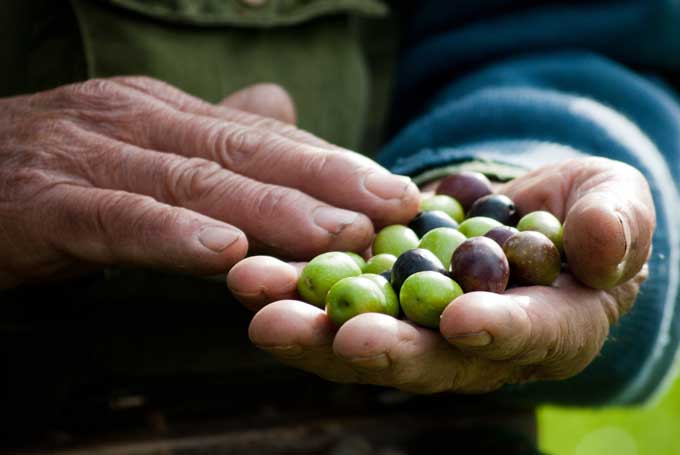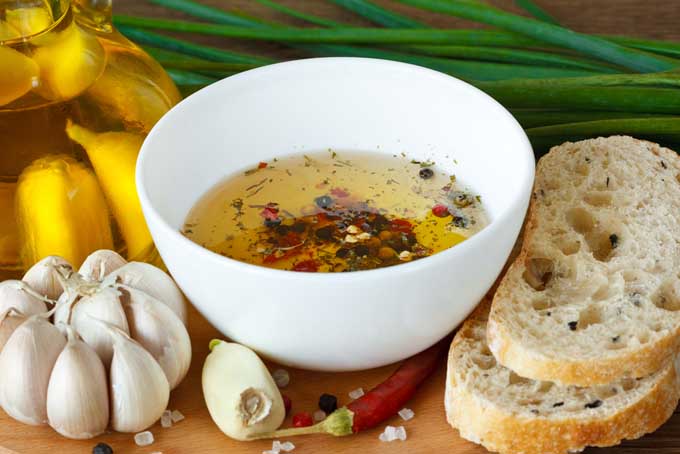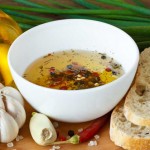Not only does olive oil taste delicious, but it is good for you, too.
A few years ago, my husband and I visited a local winery. Along with the wine tasting, we were also offered different varieties of oils, presented to us in small white bowls.
A basket of crusty bread was passed around, so we could dip into each bowl and compare the flavors.

Each selection was labeled according to region of origin, as well as grade.
Like selecting wine, taste is a matter of preference. Grades are based on the methods used to harvest and press the olives, acidity, and flavor.
Extra virgin and virgin olive oils are the finest on the market. The highest quality olives are harvested by hand and cold pressed, which means they are processed at a low temperature. Many people believe that this makes the oil taste better and contain less toxins.
With an acidity of less than one percent, the virgin oils are best used in dressings, seasoned dips, or other uncooked dishes, so that you may experience and enjoys the robust aroma and flavor. Use in leafy salads where the oil can assist in drawing out all of the healthy compounds.
Premium extra virgin and other extra virgin varieties have the best taste, while virgin can be used for cooking, yet it tastes good enough to enjoy uncooked.
Oils that are further processed after the first pressing are no longer considered virgin. They are sent to be refined via the introduction of chemicals, heat, and filtration techniques.
These lower quality varieties are referred to as semi-fine, refined, and pure. Each grade has its place in the kitchen. Lower grades are often used strictly for cooking purposes.

Olives are grown throughout the Mediterranean region and other areas of the world. Italy, Spain, Greece, France, and California are top producers.
The flavor and color of oil will vary according to a region’s climate and soil. Olives from different regions can be blended together to produce different varieties, which is economical, yet still high quality. Other producers will use olives from one region alone, producing unique flavors.
Types include:
- Spanish – yellow, fruity
- Italian – dark green, herbal
- Greek – green, robust
- French – pale yellow, mild
- Californian – light yellow, fruity
Drizzled over vegetables, splashed atop spaghetti, infused with herbs, or stirred into soup, olive oil is an essential ingredient to have on hand.
- 1/2 cup olive oil
- 4-5 cloves garlic
- 3 tablespoons balsamic vinegar
- 4 tablespoons Parmesan cheese
- 2 tablespoons crushed dried oregano
- Red pepper flakes to taste
- black pepper to taste
- Crusty Italian bread cut into chunks
- Pour olive oil into a medium sized bowl or salad plate
- Use a garlic press to add garlic to the olive oil.
- Pour in the balsamic vinegar.
- Stir in parmesan cheese, oregano, red pepper flakes, and black pepper.
- Serve with crusty Italian bread. Enjoy.

About Jennifer Swartvagher
Jennifer is an experienced journalist and author. Her work has been featured on TODAY Parents, The New York Times Blog, BlogHer, Scary Mommy, and scores of other parenting and cooking publications.






I always keep an extra bottle or two of EVOO in my kitchen because I tend to use on everything. All of my recipes call for olive oil in one form or another. Anyway, that’s a great recipe for an olive oil dip you’ve got there. Simple, yet very flavorful.
I keep a couple of bottles of extra virgin olive oil in our cupboards to mix with a nice quality aged balsamic vinegar, but I’ve not mixed the oil/vinegar combination with herbs and spices before. I shall have to try this next time we have one of our dipping breads, usually an olive ciabatta. Letting the garlic and herbs stand for an hour in the olive oil before adding the balsamic vinegar will also help infuse the flavour into the oil as well. I think our Sunday lunch might have a nice twist this week.
Thank you.
Sounds delicious. Hope you had a great Sunday lunch.
Very fascinating article about olive oil. I never knew why it was called “virgin” or “extra virgin” before today, haha. Aside from making dips, you can make a super easy salad dressing using just olive oil, some lemon juice or vinegar, and salt and pepper.
The other thing which I sometimes do when I’m hungry and it’s midnight is to heat up some leftover rice, put some olive oil and fish sauce/soy sauce on it and mix it all up. It’s really flavorful, quick and filling!
I always save the best olive oil for pasta and dipping. and other olive oil for cooking. A really good olive oil mixed with herbs and garlic with some fresh pasta is delicious and light or also used as a dressing for a pasta salad. Sometimes I add olive oil and some black pepper on my pasta and that’s enough for me.
Olive oil on pasta is one of my favorites. Last night our family enjoyed pasta with broccoli, garlic, and olive oil.
Reading this made me wonder whether the oil had been seasoned at the winery when you tasted the varieties. I wouldn’t think so if the purpose of tasting the oil is to understand the naked differences between them.
The oils were not seasoned at all.
Hi
When I was staying in Portugal, I went to two different grocery stores looking for, of course, extra virgin olive oil. I was surprised when both stores said, no such thing, all the olive oil is mixed? I couldn’t believe what I was being told. There are groves of olive trees in Portugal and my partners mother used to sell olives from her properties so I thought there couldn’t be a better place to get extra virgin olive oil. I haven’t been back since the pandemic. I am going next year and I will check again to see if anything has changed on the grocery store shelves re bottles marked extra virgin olive oil, because before it didn’t exist.
Portugal is absolutely an excellent place for purchasing oil!
Extra-virgin olive oil is cold-pressed, without using other extraction techniques. But it may still be made with a variety of olives from various sources unless described as “single origin” or the local equivalent. In Portugal, look for protected designation of origin (PDO) labeling to indicate authenticity from a particular region, such as Trás-os-Montes, and single-estate labeling. You may see the term “extravirgem” on labels as well.
Rather than shopping at the grocery store, many olive groves also offer their wares for sale via a private market on site or through other local venues. Cobrançosa is a popular local variety of olive that produces robust, delicious oil that you may enjoy. Good luck!
Olive oil is a staple here in Israel. I eat it everyday. I even worked at an oil press before, pressing unrefined oil. The unrefined, cold pressed oils are so much better for our health than the refined. Once I began using only unrefined in my diet, my health improved tremendously.
The dipping recipe seems tasty. The favorite dipping recipe here, is with olive oil, salt and zartar. So, at the next family gathering, I will have two options. Thanks.
That looks so simple yet so tasty. It would be great as a starter or even just a quick lunch. I never knew what the differences were between olive oils so thanks for letting me know!
I remember trying, trying real hard to indulge myself in olives soaked in brine, oh my, the acquired taste brought tears to my eyes and my taste buds went on vacation, my friend offered to shoulder the burden thereafter, and to my surprise it was so simple for her, she actually loved them to the last bit, away from olives and onto olive oil…and am head over heels…i ought to try out that recipe, i have never indulged in ‘olive oil dipping’ hence am quite eager…time to go on an ingredient search quest…then work on the recipe 😉
I wasn’t aware of the differences between regional varieties of olive oil. Very interesting. I always have a bottle of EVOO on hand, but I’ve never tried seasoning it for dipping. This recipe sounds delicious, so I’ll definitely have to give it a whirl.
I have always loved cooking with olive oil. There are about a million uses, and I’ve used them all! Seriously, though, I will use olive oil and cocnut oil only. And I have never regretted it
I have noticed recently an increase in specialty olive oil stores that sell all kinds of high grade stuff. You can stop in and do tastings and they will explain all the same information, but of course with the intention to sell you on the product.
Thank you for the unbiased post Jennifer! Now I am armed with the knowledge I can go into the store and shop like a pro.
I love me some EVOO. It’s funny, I was actually talking to my uncle yesterday about the different qualities of various types. I know to always go for the extra virgin, but never really knew why. He did mention about the first cold pressing, but we weren’t sure about the other types or about what differentiates varieties from different regions. This really filled in a lot of gaps in my knowledge, and I really liked the comparison to wine – it makes perfect sense.
Crusty Italian bread and olive oil for dipping is pretty much a staple of my diet. I think I’m going to make some right now.
Growing up in a predominantly Middle Eastern household, I never dreamt of using anything less than extra virgin olive oil; it was a staple in many meals and gave just the right flavor to hummus and other dips. As a result, I have not really sampled any other kinds, though I would like to try. The dip looks delectable, and I would like to try that as well. Thank you for the useful information and recipe!
My husband and I actually went to Portugal for the olive harvest. We picked a dark black variety and ended up with a couple of litres of oil. It was pressed at a small local press that uses water to cool, and the its delicious. We have actually started dipping our bread in some olive oil and salt, next time we can try this lovely dip.
How I do love a nice olive oil and cracked black pepper dressing on my salad. The only qualm I have with it is the super low smoking point. I can’t really fry anything in it, which is a shame because I feel like chicken fried in olive oil would taste divine. I haven’t had a chance to try extra virgin yet, well actually I have. I’ve tried the brand sold in stores but I’ve read in a lot of articles that the commercially sold version in stores isn’t actually extra virgin so technically I haven’t tried it. I think in order to be able to enjoy the real deal I’ll have to order it off of a specialty website. And then I’ll cry because it’s probably cost 50$ and up.
I heard that olive oil also can be used as facial cleanser, and make-up remover.
I tried it and was afraid that my skin will become oily, but it worked like magic.
I like how a lot of natural kitchen oils also can be used as beauty products.
Great list, you can’t really go wrong with Italian olive oil. Anything cold pressed gets my vote but my personal preference is a nice extra virgin olive oil from the Tuscany region.
This is really neat. I didn’t know about the difference between olive oils in the different regions. I wonder why they are so different. Is it the type of olive? The soil? The climate? All of the above? It would be interesting to see those factors broken down. Another thing I’m curious about that I didn’t see in the article: where does the olive oil that you typically buy generic in the supermarket come from? I’m from California, so I’m guessing ours are from California olives, but what about the rest of the U.S.?